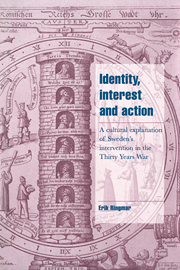 Identity, Interest and Action
Identity, Interest and Action Introduction: the beginning of the story
Published online by Cambridge University Press: 21 October 2009
Summary
Why are there wars? Why have human beings in practically all times and places seen it fit to kill each other, not just on an individual and one-on-one basis, but as a matter of official policy, backed up by the full resources of a community, a city or a state? And why has war participation often been regarded, not as a moral wrong, not even as a necessary evil, but as a heroic, glorious, enterprise? The answer to questions such as these may seem easy enough to find once we remember that wars in a certain respect are similar to games, namely occasions on which things can be won and lost. Statesmen, just like prospective game players, conclude that on balance they may stand to benefit from participation, and once this conclusion has been reached they simply act upon it. States go to war since going to war is in their interest to do; states act rationally, in order to maximise their gains or in order to minimise their losses.
On second thought, however, this rationalistic answer may not be entirely convincing. As any historian is able to tell us, the forces unleashed in a war are inherently difficult to assess beforehand: alliances shift, morale falters, rapid technological changes cause rapid transformations in the balance of power. Similarly the risks involved in a war are invariably high: a regime may be overthrown if defeated, the country may be invaded and occupied.
- Type
- Chapter
- Information
- Identity, Interest and ActionA Cultural Explanation of Sweden's Intervention in the Thirty Years War, pp. 1 - 16Publisher: Cambridge University PressPrint publication year: 1996
